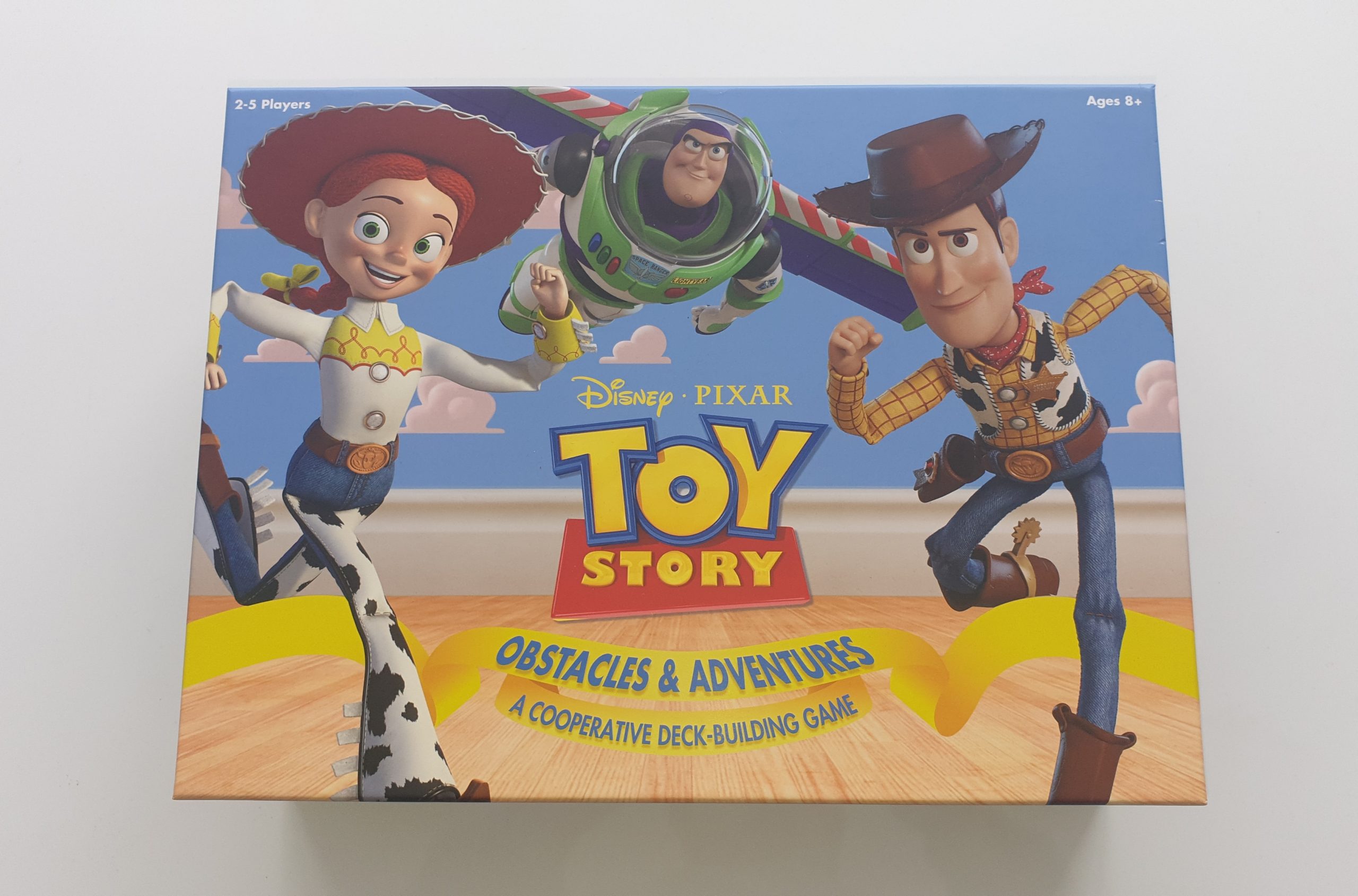Toy Story: Obstacles & Adventures is a cooperative deck building game, which re-implements The Op’s previous board game Harry Potter: Hogwarts Battle. Designed by the team of Prospero Hall the game sees 2 – 5 players take up the roles of some of the most iconic Toy Story characters and make friends with the rest of the toy box! Woody, Buzz Lightyear and friends will battle against the likes of Sid and Prospector Pete across six adventures. However, will players want to overcome the hazards and dangers of being a toy? Let’s find out!
Choosing a toy to play as, and opening the box labeled Adventure 1, the first game begins. Each toy comes with their own deck of 10 basic cards, which players will start each adventure with – before looking to improve the deck during play. Also included in each box is an adventure track board, which players will track the increasing danger level and time running out.
Taking on a selection of hazards in each adventure, players will place the end boss face down on the central board, with additional hazards shuffled on top. Finally, a market of six cards is made, though unlike in Harry Potter: Hogwarts Battle duplicates are combined into one market slot.
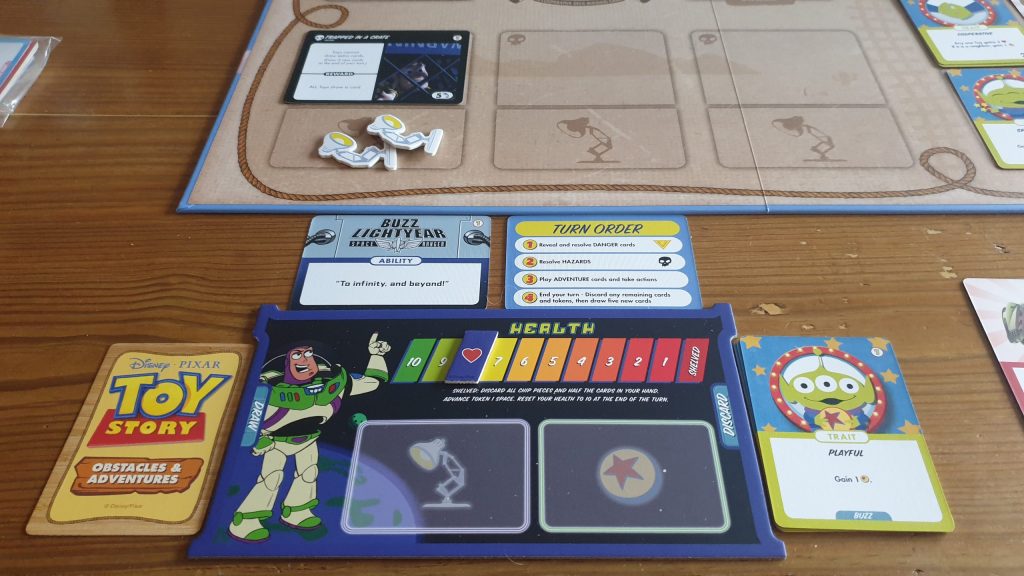
After all players have drawn five cards from their individual shuffled decks it’s time to play. Taking it in turns, players will start by flipping over danger cards – the amount indicated by the adventure track. Dangers can see the active toy losing health or cards, a negative effect that applies to all players or moving the token forward on the adventure track.
Next the active player checks all hazards in play to see how they impact the game. Hazards, alongside needing to be beaten to win, make aspects harder for players. Not wanting to reveal too much of the boxed content, examples of those in adventure 1 will make the active toy lose health each turn or stop them drawing additional cards during their turn. Those in adventures later in the game however are more inventive in quite how they trip players up. In adventure 1 only one hazard is revealed at a time. Assigning insight tokens to a hazard sees it overcome and removed from play – with the next hazard revealed at the start of the next player’s turn.
After seeing how the board is fighting the toys, the active player can then use their five cards. The basic cards will only get players so far, with most producing imagination that can be used to purchase new cards from the market. Any new cards are placed onto your discard pile, you are not able to use them yet. Overcoming the hazards is how players win, with some cards producing insight tokens, that can be assigned to hazards. By default all tokens that are not spent are lost at the end of a turn, so it is often best to use them where possible. At the end of a turn the active player places all cards from that round onto their discard pile, before drawing a hand of five cards. If this causes their deck to run out their discard pile is shuffled, becoming the draw deck.
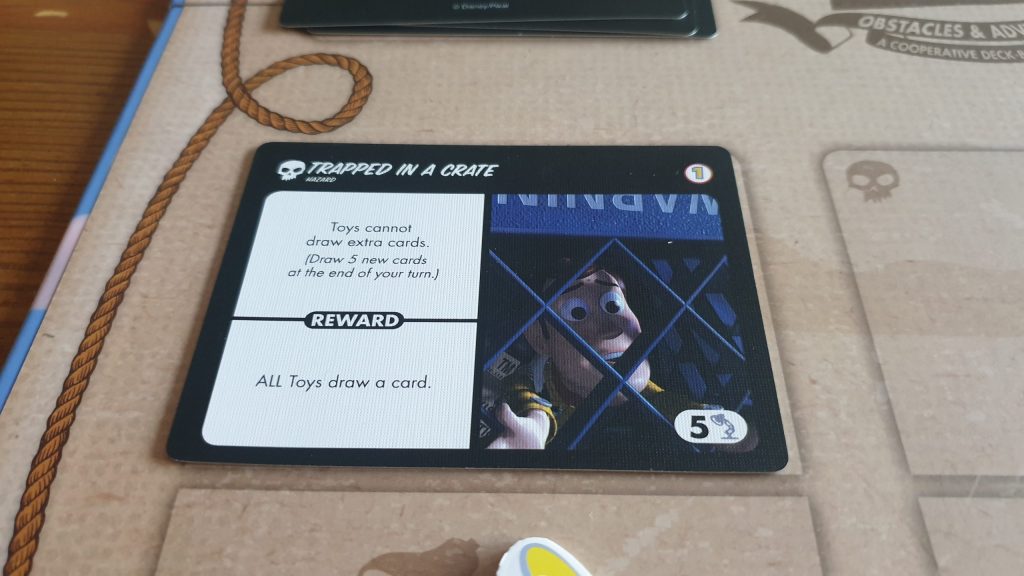
Whenever a hazard is overcome all players gain the benefit listed. These often are the inverse of the negative effect it was having – giving health or moving the token backwards on the adventure track. Health is helpful as whilst toys cannot be killed if their health hits 0 then they are shelved. Being shelved causes the player to discard cards and the adventure token moves onward one space. The game continues clockwise around the table until one of two outcomes occur. If the token hits the end of the adventure track the game is lost, signalling that time has run out. The toys win if they overcome all of the hazards before this happens.
Giving a length of play for Toy Story: Obstacles & Adventures is extremely hard. While the first playthrough of adventure 1 took around 35 minutes, this decreases playing through a second time. For the most part each subsequent adventure adds a little time wise to the experience, through to the final adventure which lasted around an hour – after a failed attempt (or two). There are also ways to make adventures harder and some slightly easier – which will again alter the length. Just know you’ll probably want to set aside an hour to be safe – at minimum as most often we wanted to play the next adventure straight away.
As with any campaign game, part of this drive to play is opening the boxes! Finding out what new cards were added to the adventure deck – seeing more characters added – was something to look forward to, as well as whom the toys face next. There are a few minor surprises that tweak the gameplay, allowing it not to become stale – though nothing major changes the experience past the difficulty. Adventures 1 – 3 almost lull players into being complacent. Adventure 4 kicks up the difficulty with a new style of hazards and dangers to overcome. Just as the game feels easy it proves you wrong, with a distinct change from a cheery light-hearted experience into one that requires actual teamwork.
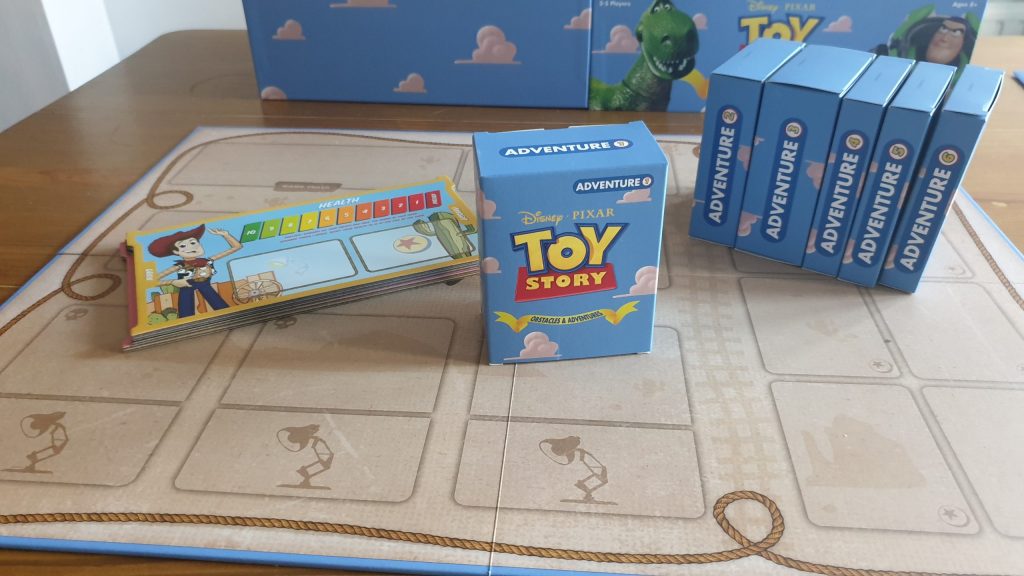
Combined Hazard and Danger cards can be brutal if not dealt with swiftly. An example was when a hazard that made players lose health if forced to discard. On it’s own it was fine until a few dangers that forced players to discard appeared in a row – losing players cards and health. To some extent this leads Toy Story: Obstacles & Adventures to feeling like at any moment the game could be lost. Even when the token is near the start of the adventure track it feels like any danger could tip the balance if it synergizes with a hazard. Part of this is the ever looming potential for things to snowball towards doom, that only builds as players start to draw more dangers during every turn.
With two players we got a lot out of the experience. Adding in more players is balanced by the amount of times it is not the active player but all players that get damaged – so there shouldn’t be anything mechanically stopping the game work all the way up to 5. Nevertheless, groups of 4 – 5 may struggle staying engaged. There is little to do on other players’ turns, other than loosely guide them if they ask for some help, or participate in a team talk of which hazard to add insight to first. There are cards and effects that trigger on other players’ turns, to hold some attention. Still, mostly it would be a long wait for a turn with nothing to do other than watch other players’ turns unfold.
Whilst there is a difficulty to Toy Story: Obstacles & Adventures the deck building aspects are on the simple side. There are many different cards in the adventure deck, though they all fall into three types: items, traits and friends. Surprisingly, there are also no instant benefits from buying cards that other deck builders have used. This could have made deciding between buying market cards that bit more interesting. As the cards themselves go though they are of high quality. The art that adorns the cards is a mixture of film renderings and artwork, which is a little odd. Though, this most just sees the aliens, that are on traits, having a slightly different style to them.
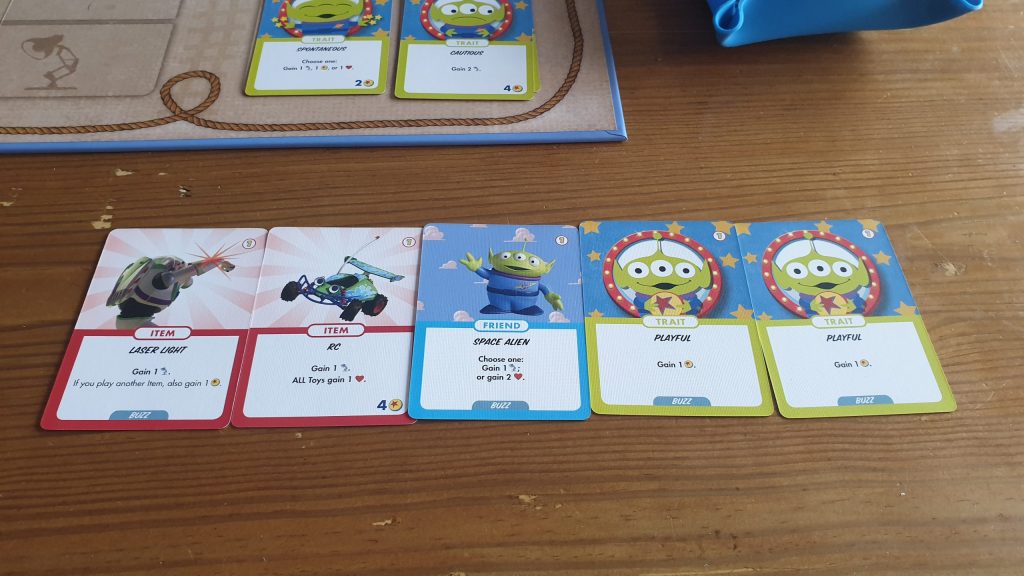
There is no denying that the theme of Toy Story itself is epic. Alas, despite some attempts at making cards have thematic actions it feels merely pasted on. There are some occasions where there is a thematic tie – such as Playtime with Sid damaging a toy, Hamm allowing players to save tokens and the fact the army men work together. Then, there are the likes of the friend card RC that heals all toys, which make no intuitive sense. The 5 main playable characters do feel unique towards the end of the adventures. Yet, choosing one of them, it never feels like you are Rex with his abilities not linked to his character. There is a fun side to being the characters of Toy Story, it just could have been even better with a fully thematically deck of cards.
Toy Story: Obstacles & Adventures offers gamers a streamlined cooperative deck building experience, that does ramp up in difficulty to provide a challenge. The theme is one that so many people will enjoy regardless of the pasted on nature, it just could have elevated the experience that little higher. What comes out of the six adventure boxes, doesn’t drastically change things, but adds variety and twists to keep players wanting to carry on and open the next one. After completing the game there isn’t much of a drive to continue, with only a few minor ways (such as starting higher on the adventure track) to increase the difficulty. Still, it is an experience players can get a solid amount of entertainment out of, and who doesn’t want to play as a character from Toy Story?!
(Editor’s Note: Toy Story: Obstacles & Adventures was provided to us by Asmodee for the review. The game is currently available from local board game stores, some of which are running dropoff services, find your local store here.)

